
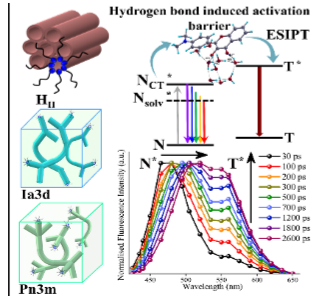
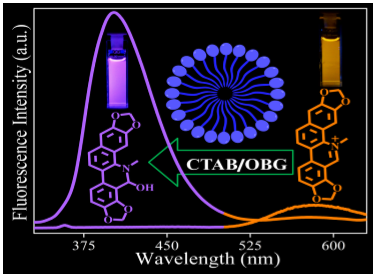
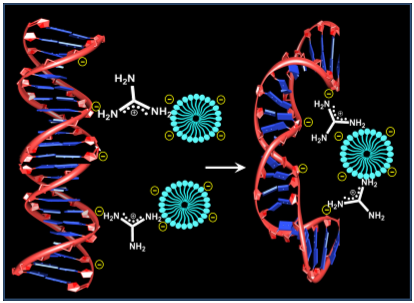
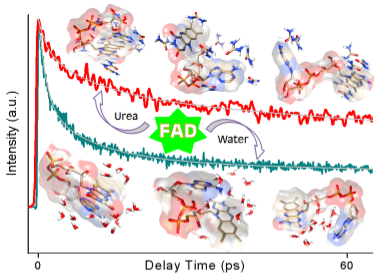
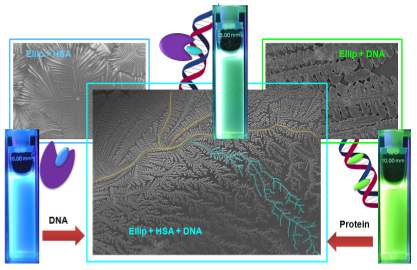
|
Home |
|
Welcome to Dr. Partha Hazra Group |
|
Dr. Partha Hazra Professor Indian Institute of Science Education & Research, Pune Department of Chemistry, Dr. Homi Bhabha Road, Pashan, Pune, Maharashtra 411008, India Phone: 020-2590 8077 E-mail: p.hazra@iiserpune.ac.in
|
|
Present Research Interests: Spectroscopy of Materials, Photophysics and Biophysics
vDesign, Synthesis and Photophysics of Novel Thermally Activated Delayed Fluorescence (TADF), MR-TADF and Mechanochromic Fluorescent Luminogens
vDesign, synthesis and photophysics of PERSISTENT room temperature phosphorescent (RTP) organic molecules.
vSynthesis, Optical Properties of Luminescent Copper Dinuclear Complexes and Chain Clusters.
vProbing ultrafast fluorescence dynamics of metal nano-clusters, copper dinuclear Complexes and Chain Clusters.
|
|
Teaching, Research Experience & Education:
Professor in IISER, Pune from May, 2021 onward.
Associate Professor in IISER, Pune from August, 2014-April, 2021.
Assistant Professor in IISER, Pune from February, 2009-July, 2014.
Post-doctoral fellow (availed JSPS fellowship) in Kyoto University, Japan from 2004-2007 in Prof. Masahide Terazima Group.
2005, Ph. D. in Chemistry, Indian Institute of Technology (IIT), Kharagpur (Advisor: Prof. Nilmoni Sarkar)
1998, M. Sc. in Physical Chemistry, Burdwan University, India |
|
Glimpses of Published Works |

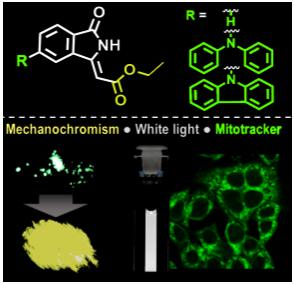
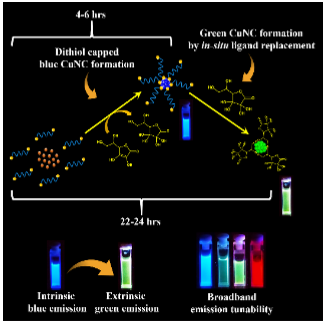
|
The present study shows that a special class of ionic liquid (Gua-IL) can act as a stabilizer of telomeric GQ-DNA exerting minimal effect towards the duplex structure and thereby can be considered as a potential telomerase inhibitor. Phys. Chem. Chem. Phys., 2016, 18, 29740-29746. |
|
Dual fluorescence property of an eminentt anticancer drug, ellipticine, has been explored to directly monitor its efficient loading into MCM-41 and subsequent release to DNA. Nanoscale, 2016, 8, 18436-18445. |


|
Investigation of Photopyrolytic Processes of an Anticancer Drug Topotecan inside Biocompatible Lyotropic Liquid Crystalline Systems. Langmuir, 2016, 32, 3057-3065. |

|
An antimalerial/anticancer drug, Cryptolepine is encapsulated inside the nano-cavity of cucurbit[7]uril, and its subsequent release to DNA is monitored using an external stimulus, acetylcholine chloride. ChemPhysChem, 2016, 17, 506-515. |

|
Solvation dynamics has been investigated in different Phases of lyotropic liquid crystalline systems. J. Phys. Chem. B, 2015, 119, 11721-11731. |
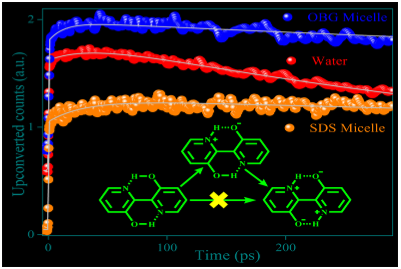
|
Femtosecond Up-conversion Studies of [2,2-Bipyridyl]-3,3-diol in Octyl-β-D-glucoside and Other Micellar Aggregates. J. Phys. Chem. A, 2015, 119, 12715-12721. |
|
Fluorescence Switching of Sanguinarine in Micellar Environments. Phys. Chem. Chem. Phys. 2015, 17, 20725-20732. |
|
An ionic liquid induced Green Solvent Induced DNA Package. Scientific Reports, 2015, 5, Article number: 9137. |

|
Biophysical aspects of binding interactions between anticancer drug, Proflavine and human telomeric DNA have been monitored with different spectroscopic techniques. We have observed that Proflavine instigates and stabilizes the G-quadruplex DNA.J. Phys. Chem. B, 2014, 118, 11090-11099 |
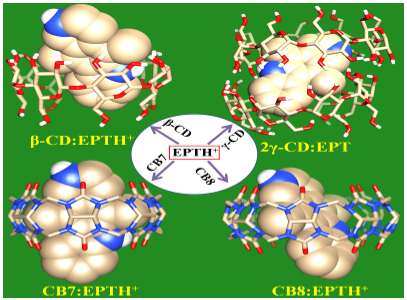
|
Prototropical and photophysical properties of an anti-cancer drug, EPT are explored inside the inclusion complexes formed by cyclodextrins and cucurbit[n]urils using spectroscopic and computational studies. J. Phys. Chem. B, 2013, 117, 14099-14107. |

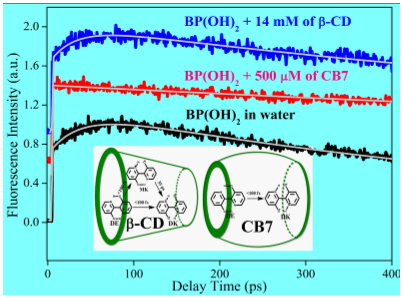
|
The effect of physical nanocavity on double proton transfer dynamics of BP(OH)2 is studied from femtosecond to nanosecond regime using TCSPC and fluorescence upconversion techniques. Phys. Chem. Chem. Phys. 2014, 16 (3), 933 - 939. |
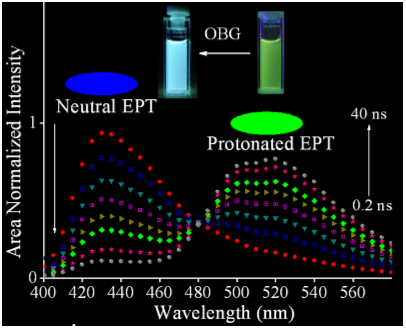
|
Prototropical and photophysical properties of an anticancer drug, ellipticine are explored inside the octyl-b-D-glucoside micelles using steady state and time resolved spectroscopic techniques. Phys. Chem. Chem. Phys. 2014, 16, 14953-14960. |
|
Urea Induced Unfolding dynamics of Flavin Adenine Dinucleotide (FAD): Spectroscopic And Molecular Dynamics Simulation Studies from Femto-second to Nano-second regime. J. Phys. Chem. B, 2014, 118, 1881-1890. |
|
A clearly visible emission color switching of an anti-cancer drug, ellipticine in presence of protein (blue), DNA (green) and protein-DNA system (sea green) promotes a novel technique to probe protein-DNA interaction. Phys. Chem. Chem. Phys. 2014, 16, 3914-3917. |
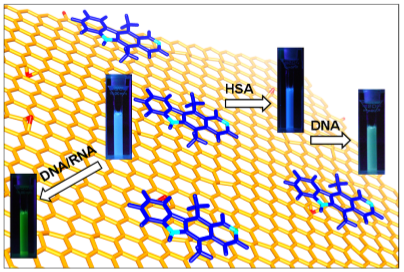
|
Sensing of Bio-molecules Using Fluorescence-Switch: Dual fluorescence property of an eminent anticancer drug, ellipticine, has been explored to directly monitor its efficient loading onto graphene oxide and subsequent release to biomolecules like DNA/RNA. Nanoscale, 2014, 6, 2937-2944. |
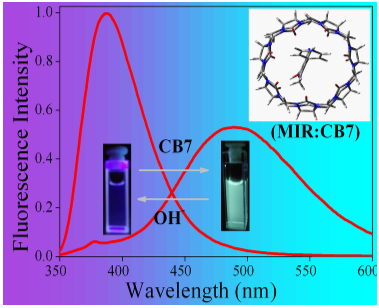
|
A fluorescence switch from ultraviolet (UV) to visible (cyan) is observed as a consequence of upward pKa shift of milrinone inside the CB7 nano-cavity. Phys. Chem. Chem. Phys. 2014, 16(7), 2823-2826. |
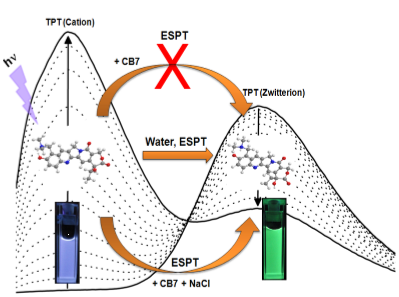
|
Inside the nano-cavity of CB7, ESPT of TPT is inhibited and fluorescence switches from green to blue (see picture). When NaCl is introduced into the TPT-CB7 solution, the blue colour switches back to green. ChemPhysChem, 2013, 14 3375-3383. |

|
ESPT dynamics of a potential anti-cancer drug, Topotecan has been explored in aqueous reverse micelle using steady-state and time-resolved fluorescence measurements. J. Phys. Chem. B, 2015, 119, 2363-2371. |
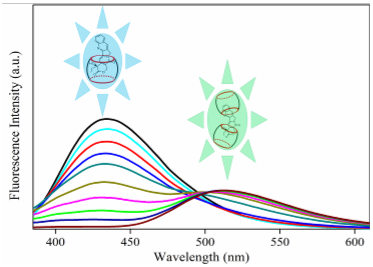
|
Cucurbit[7]uril (C7U) assists the pKa shift of an anticancer drug, 20(S)-camptothecin (CPT) by forming 2:1 (C7U:CPT) inclusion complex. However, the protonation does not take place when it is encased by β-cyclodextrin cavity. ChemPhysChem 2013, 14, 532. |
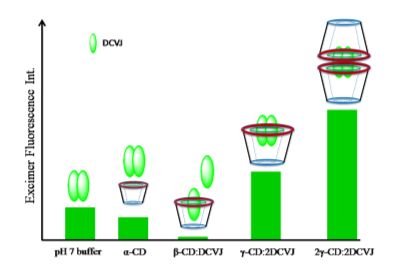
|
The modulation over excimer formation drift of a molecular motor, called DCVJ, have been probed inside various cavity sizes of cyclodextrins host. Phys. Chem. Chem. Phys. 2013, 15, 330 |

|
The binding interactions of flavins (riboflavin (RF), flavin adenine dinucleotide (FAD) and flavin mononucleotide (FMN)) with HSA have been monitored with the help of steady state and time-resolved fluorescence spectroscopy, isothermal titration calorimetry, circular dichroism studies, and supported by docking and molecular dynamics (MD) simulations studies. ChemPhysChem. 2012, 13, 2142-2153. |
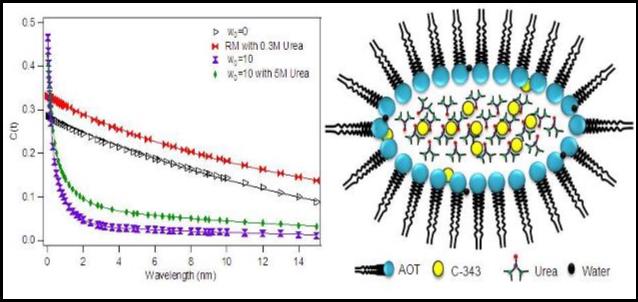
|
In this work the urea dynamics inside AOT reverse micelle has been monitored without intervention of water using time resolved fluorescence techniques from picosecond to nanosecond time regime. Urea dynamics inside the reverse micelle is severely hindered compared to dry as well as water RM due to the formation of highly networked molecular cluster of urea. J. Phys. Chem. A, 2011, 115, 10398-10407. |
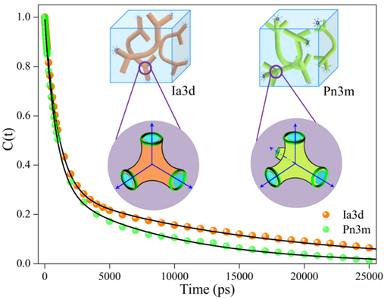
|
Impact of Topology on the Characteristics of Water inside Cubic Lyotropic Liquid Crystalline Systems. J. Phys. Chem. B, 2019, 123, 18, 4118-4128. |
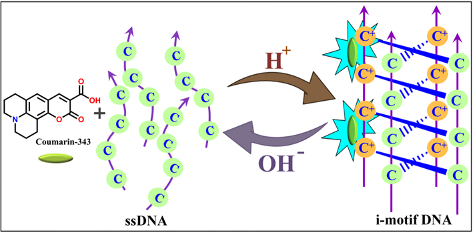
|
A new approach has been explored to detect i-motif DNA structures based on the hemi-protonated cytosine-cytosine (C+-C) base pairing recognition instead of conventional loop detection of i-motif DNA. Along with its selectivity towards i-motif DNA over its complimentary GQ DNA, this approach shows its versatility by detecting different kind of i-motif structures with different chain lengths, molecularity and sizes etc. Organic & Biomolecular Chemistry (OBC) 2019, 17, 5392-5399. |
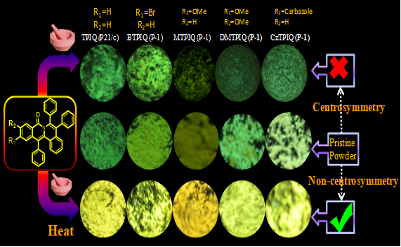
|
Strategy to Mechanical Activation of Centro-Symmetrically Packed Organic Luminogens. J. Phys. Chem. C, 2019, 123, 3848-3854. |
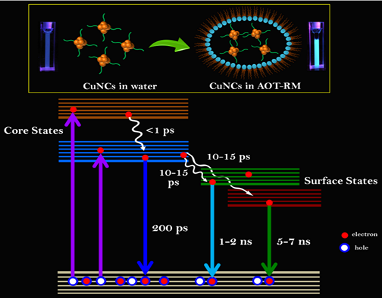
|
Ultrafast Fluorescence Dynamics of Highly Stable Copper Nanoclusters Synthesized inside the Aqueous Nano-pool of Reverse Micelles. J. Phys. Chem. C, 2018, 122, 5742-5752 . |
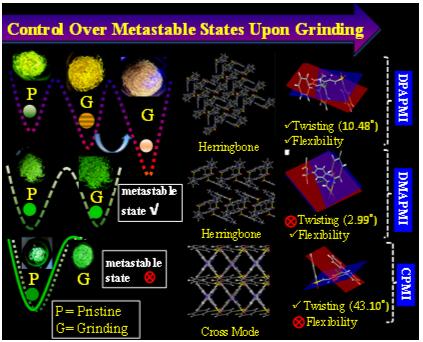
|
Developing Structure-Property Relationship to Design Solid State Multi-stimuli Responsive Materials and Their Potential Applications in Different Fields. Chemical Science, 2018, 9, 3592-3606. |

|
Hydrogen Bonding Abilities of LLC Water Molecules and their Effects on Intramolecular Hydrogen Bonds of Target Probe Molecules. PCCP, 2020, 22, 6210-6221. |
|
A new approach has been explored to instigate the formation and stabilization of i-motif DNA at neutral and alkaline medium by means of incorporating into mesoporous silica nano-channels (MCM-41). Additionally, this i-motif DNA formation has been controlled using positively charged lysozyme protein which drags the DNA from the nano-pore followed by protein-DNA complex formation. Chemical Communications, 2018, 54 (51), 7054-7057 . |
|
In this work, we have reported an all in one type single source white light emitter with mito-tracking ability and stimuli responsive behavior. J. Phys. Chem. Lett. 2021, 12, 1162. |
|
In this work, we have probed proton coupled electron transfer (PCET) inside the aqueous nano-channels of liquid crystals. J. Phys. Chem. Lett. 2021, 12, 2651-2659. |
|
Broadband emission tunability in thiol protected Cu nanoclusters has been achieved through in-situ ligand engineering, where the reducing agent plays the key role. Phys. Chem. Chem. Phys., 2021, 25850-25865. |

|
In this work, we have developed a quantitative relationship between the molecule binding event with aggregating species, and the resulting modulation of the overall aggregation process. Biochemistry, 2022, 61, 21, 2267-2279 . |
|
In this work, we have shown a strategy to achieve aggregation induced emission (AIE), room temperature phosphorescence (RTP) and multi-stimuli response from a single organic luminogen through directed structural engineering. J. Phys. Chem. B, 2021, 125, 12832-12846. |


|
One PhD position is available. Interested and motivated candidate can send e-mail to me. |
|
Tuning of TADF efficiency of three donor-acceptor based organic molecules was carried out using a regio-isomeric approach. Chemical Science, 2023, 14, 13832-13841. |


|
This work provided a structure-property relationship to achieve effective harvestation of triplet excitons in iodide-bridged rhombic Cu2I2 complexes, and their effective utilization in OLED device fabrication and non-linear photon up-conversion processes. J. Phys. Chem. Lett. 2024, 15, 6069. |